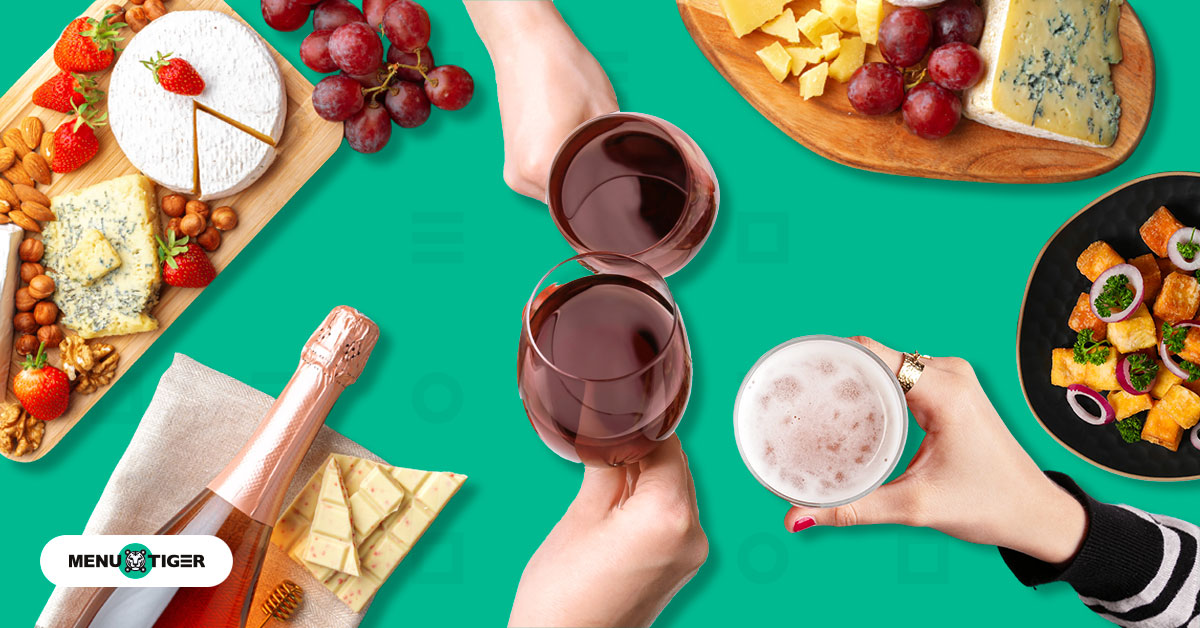Highlighting food and drink pairing ideas or suggestions on your menu is one factor in increasing your profit and improving your service.
When you’re in the process of creating your menu, do note that matching a specific food item with the right beverage will uphold a good first impression from first-time diners and inspire the regulars to keep on coming back for more.
In a way, you can consider this as one of your restaurant’s cash cows.
No need to spend on extravagant marketing campaigns. All you need is the right interactive restaurant menu software to help you curate your menu with ease.
Table of Contents
ToggleWhy is food and drink pairing important?
While it’s true that food and beverage pairing adds sophistication to your menu, it’s also important to note that this is a menu engineering strategy to promote your offerings and boost your profit.

Apart from that, it’s also one of the best ways to enhance and complement the flavors and textures of your dishes, fostering a memorable dining experience.
And once they get a positive experience, chances are they’ll most likely come back for more. Now this secures repeat business and a potential regular customer.
You can also use food pairing ideas as a marketing opportunity for your fine dining restaurant.
By highlighting your expertise in creating harmonious flavor profiles, you attract food enthusiasts and connoisseurs who appreciate the artistry behind your menu.
How do you pair food and beverages?
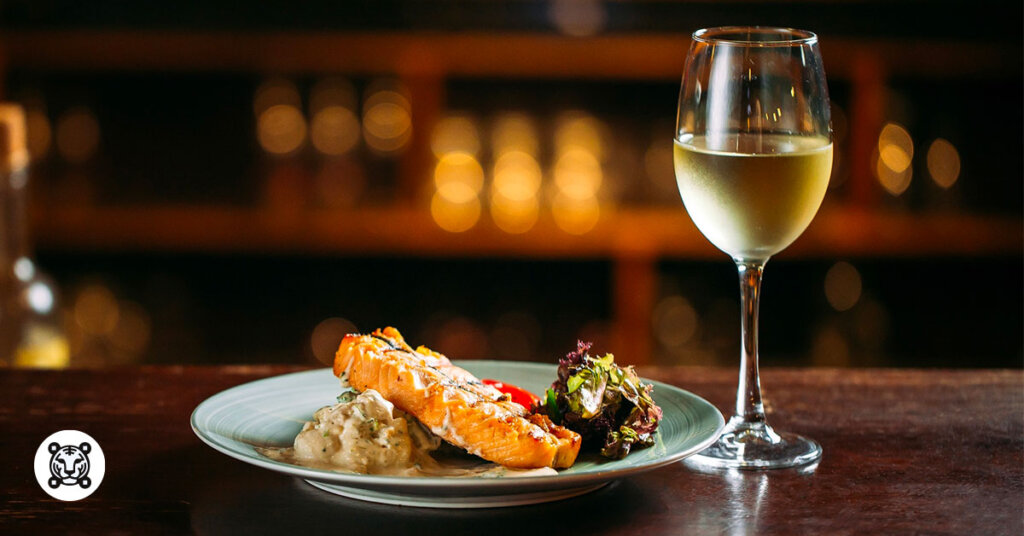
Complementary flavors
When it comes to complementary pairing, you need to find a balance between two contrasting elements. Your goal here is to create well-matched flavors that will enhance your customers’ dining experience.
Here are examples of the best food and drink combos:
- For spicy and sweet dishes, the most ideal option is a sweet, fruity, and citrusy cocktail. This is because the sugar and citrus mute the burning sensation in the mouth and add a refreshing note instead.
- Salty and tangy dishes, on the other hand, go well with full-bodied or full-flavored drinks like Pinot Noir, soda fruit drinks, or beer. These drinks will cut through the saltiness offered by the food and balance out the flavor with a swig or a sip.
- A rich, creamy dish for World Pasta Day will need a beverage that cleanses the palate and perfectly matches the rich texture. Your options should include light lagers, a gimlet, or a dry white.
Contrasting textures
Talking about contrasting textures means exploring a delightful interplay between the mouthfeel of food and drink.
Textures add a subtle excitement to your customers’ palate, usually creating a dynamic and memorable combination.
Here’s how you can master this art:
- Think of dishes with a satisfying crunch—perhaps battered and fried items like tempura vegetables, crispy chicken, or a perfectly baked pie crust. The crispy texture can complement a creamy beer, velvety Chardonnay, or a cocktail with a creamy base.
- Pairing a silky-smooth soup with a crunchy crouton or a tender steak with a crispy onion garnish creates a good kind of sensation in each mouthful. To play with the contrast of textures, offer oaky and creamy Chardonnay along with the creamy soup, and deep-flavored drinks like classic red, whisky, martini, or a club soda should be suggested for the steak.
Consider the weight
In food and drink pairing, “weight” refers to the overall intensity and richness of the dish and the beverage.
If your customer orders a light dish, you should suggest a light drink to match it. Heavy meals or dishes should be paired with heavy beverages, too.
Mismatching your drinks and food could cause an unpleasant dining experience. It’s either your food will overpower the beverage served, or the beverage will overwhelm the food.
Best food and drink combos
Mastering how to pair food with drinks can significantly elevate your dining experience. Understanding the types of the best food and drink pairings allows you to create menu item combinations that enhance the flavors of both the dish and the beverage.
Ultimately, this will help you cater to diverse customer preferences and boost customer satisfaction.
Pairing wine and food
Wine, with its rich history and cultural significance, stands as a timeless companion to exquisite fine dining.
The industry is blessed with various wines, each offering a unique flavor profile that intensifies dining to new heights.
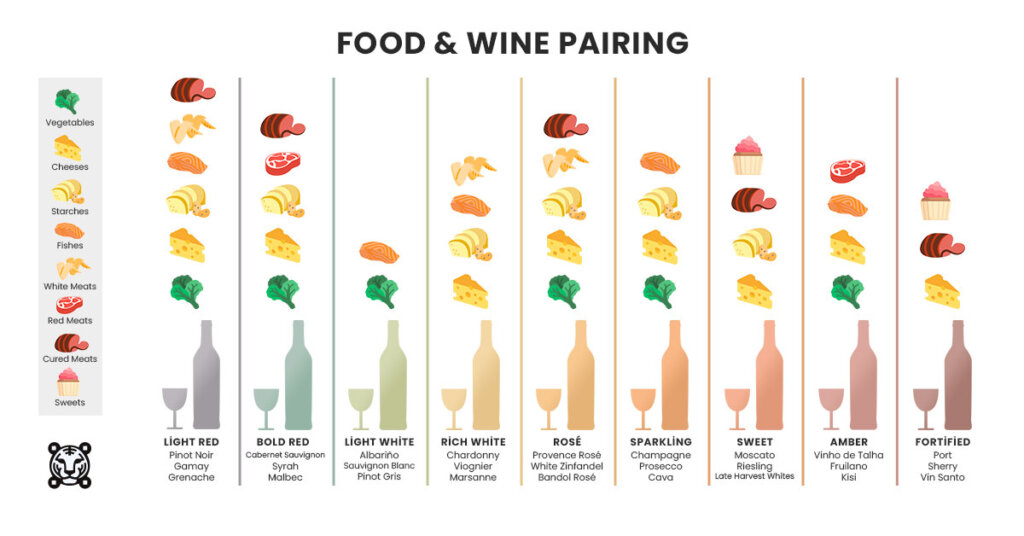
Here are few wine pairing examples:
Red wine pairings:
Reds are characterized by their bold and robust flavors. So, it’s important to accompany them with dishes that can withstand their intensity.
Consider offering this with flavorful options like steaks, grilled meats, and rich stews. A great menu example is a bold Cabernet Sauvignon with a perfectly cooked filet mignon.
White wine pairings:
In contrast to their red counterparts, white wines are known for their lighter and crisper characteristics.
They are excellent when paired with delicate dishes such as seafood, poultry, and lighter fare.
So, if you have a lemon-infused grilled halibut, it’s best to recommend a citrusy Sauvignon Blanc.
Sparkling wine pairings:
Sparkling wines have the ability to complement a wide range of dishes. They’re not limited to specific courses and can be a delightful addition, from appetizers to desserts.
Whether it’s a celebratory pop of Champagne or the playful fizz of Prosecco, sparkling wines bring a touch of elegance to any meal.
You can try them with appetizers, seafood, or even desserts, as the carbonation cuts through the richness, leaving a palate-cleansing effect.
Pairing beer and food
Crafting a well-rounded beer selection can significantly enhance the flavor profiles of your dishes.
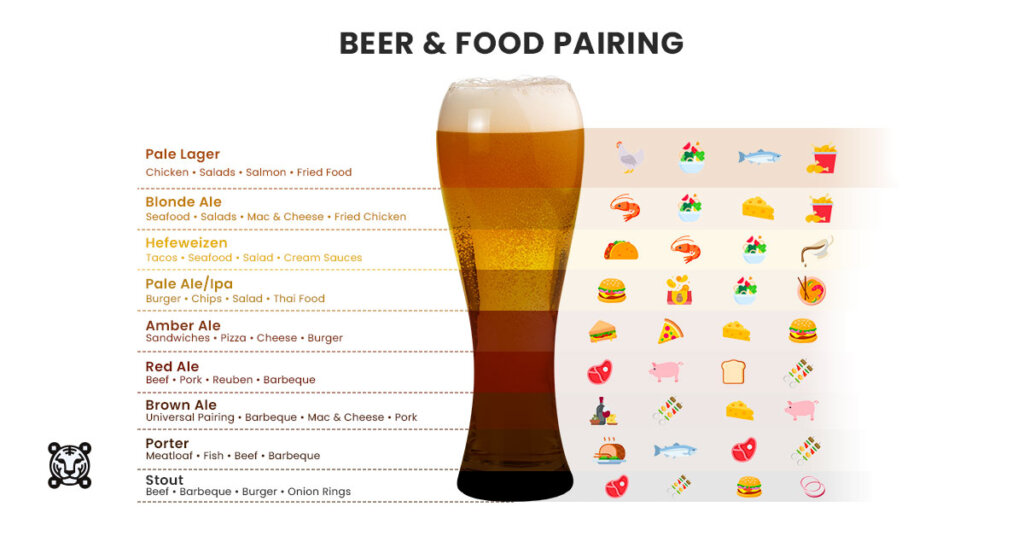
Here are a few food pairing suggestions for your various beer types:
Lagers pairing:
Lagers are known for their crisp and refreshing qualities, making them excellent companions for grilled meats and seafood.
A good pairing example would be matching a lager with lemon-roasted salmon or seared scallops. The crispness of the beer complements the savory notes of the seafood flavors.
Ales pairing:
Ales offers a diverse spectrum of flavors, making them suitable for pairing with a wide range of dishes.
Their versatility shines when paired with bold and spicy elements in your menu. A good example? Indian cuisine.
Imagine pairing a spicy curry dish with an Indian pale ale. The hoppy notes of the IPA cut through the richness of the curry, which creates an explosion of complementary flavors.
Stouts and Porters pairing:
Rich and robust, stouts and porters bring depth to your beer selection and are perfect for enhancing the sweetness of desserts.
These dark beers can add a layer of complexity to your menu, providing a satisfying conclusion to your customers’ meals.
And this also means that this beer is the best match for decadent desserts like chocolate cakes.
Pairing spirits and food
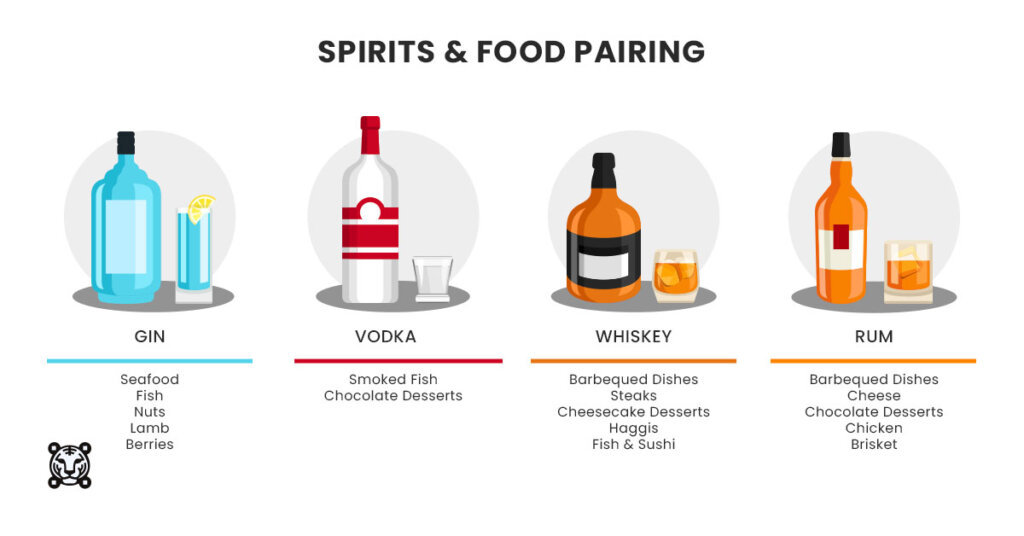
Whiskey pairing:
When curating your whiskey and food pairings, you must avoid excessively spicy and fatty food. These are the flavors that will double or tone down the strong kick of any whiskey.
What you can offer instead are food items that you commonly find on a charcuterie board. Yes, we’re talking about nuts, succulent fruits, cheese, prosciutto, smoked ham, hummus, pâté, or even chocolate.
Gin pairing:
While most people enjoy drinking gin straight out of the glass or paired with tonic, juice, or soda, there might be a few customers who would love to have it with their meal.
This is because bartenders now found a way to match the botanicals present in this spirit with the botanicals used in preparing the food.
A good example would be pairing a citrusy or herbal-based gin with seafood like the classic smoked salmon.
The fat in the smoked salmon complements and offers a rich taste to the gin. The spirit also helps wash away the taste, cleansing the palate after each sip.
Rum pairing:
Rum is known for its sweet and sometimes spiced profiles. This makes it a good pair for spicy and tropical dishes.
For example, you can serve rum alongside a mango salsa-topped chicken or pair a spiced rum with a pineapple-glazed pork dish. You can also try it with a plate of jerk chicken or spicy barbecue wings.
Pairing non-alcoholic drinks with food
Gone are the days when non-alcoholic options meant a basic soda or fruit juice. These days, you can offer better alternatives to teetotalers and those who are the designated drivers of the day.
And make sure they will get the best experience by pairing their drinks with these food items:
Mocktails pairing:
If they’re having a virgin mojito, it’s best to pair it with light appetizers such as bruschetta or Caprese salad because the crispness of this mint-lime concoction complements the freshness of the appetizers.
If your customers are getting grilled chicken or fish, you can suggest a fruity mocktail like berry sparkler to balance out the savory flavors of grilled proteins.
But if your patrons are looking for romantic brunch ideas, a citrus-based mocktail will help cut through the richness of the brunch fare.
Lemonade pairing:
When pairing non-alcoholic drinks with food, it might involve timeless favorites with picnic-style fare such as sandwiches, salads, and fresh fruit.
You can add a twist to this tangy drink by adding fresh mint leaves or ginger slices. These enhanced lemonades can be paired with sushi rolls and even Mediterranean dishes like grilled lamb skewers or falafel wraps.
Agua Fresca pairing:
This Mexican beverage offers a burst of flavor that complements a whole lot of dishes and is perfect for cooling down on a hot day.
Pair it with spicy Mexican menu items, seafood ceviche, shrimp cocktail, or Caribbean-inspired dishes. The sweetness of the agua fresca will balance out the spices, acidity, and smokiness of these food items.
Seasonal food and drink pairing ideas
Seasonal ingredients and desserts offer endless opportunities for creative pairings, allowing you to showcase the best flavors for each season.
Whether you’re offering al fresco dining service in the spring or cozying up the restaurant in the winter, you can use the seasons to guide you in making profitable menu ideas.

Here are some seasonal food and beverage pairing examples:
Spring menu suggestions
With spring comes fresh produce, which means fresh ingredients for your dishes. And this is also the right time to bring out a crisp Sauvignon Blanc or a refreshing mocktail to the table.
Why does it work, you may ask? It’s simple.
The acidity of a light Sauvignon Blanc complements the crispness of the fresh greens, while a cucumber mocktail adds a cooling touch to your customers’ palate.
You can also pair these drinks:
- Rosé Wine;
- Gin and tonic;
- Sparkling water with lemon and basil; and
- Mint julep
With these food items:
- Spring salad;
- Asparagus risotto;
- Lemon herb chicken;
- Pea and mint soup; and
- Grilled salmon with mango salsa.
Summer menu suggestions
Summer brings an abundance of fresh, seasonal ingredients ripe for culinary exploration. From succulent fruits to crisp vegetables and fragrant herbs, the possibilities are endless.
You can incorporate these seasonal delights into your dishes and pair them with the perfect beverages.
Think of juicy grilled peach and burrata crostini served with a crisp and citrusy Sauvignon Blanc or light and refreshing Rosé.
Additionally, you can’t go wrong with a classic summer salad featuring watermelon chunks, tangy feta cheese, and fresh mint leaves with a chilled glass of Prosecco or a cucumber and mint-infused sparkling water.
Fall menu suggestions
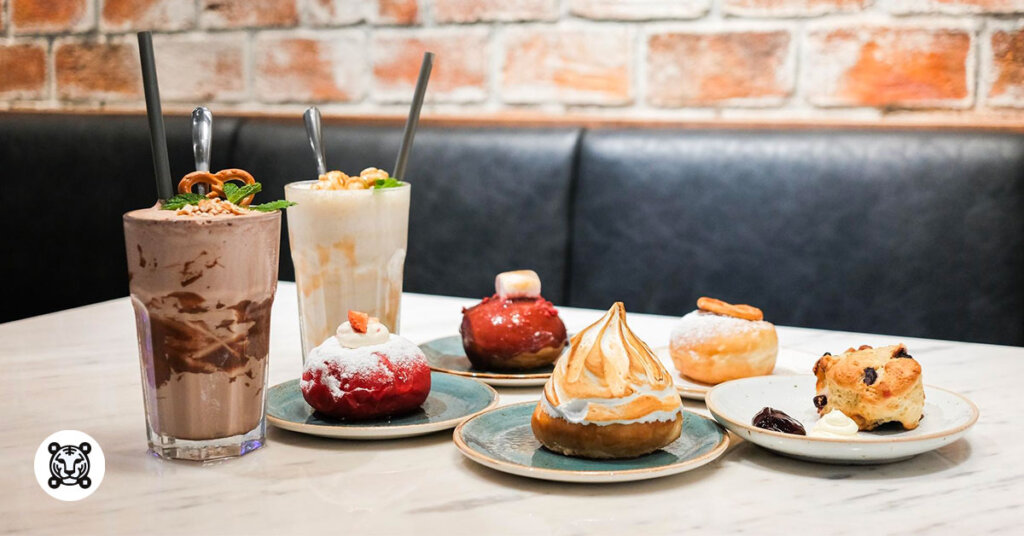
During fall, your patrons might crave drinks that are cozy and comforting, with flavors that complement the hearty dishes on the menu.
Doesn’t matter if it’s a bold wine to accompany a savory toast or if it’s a spiced cocktail to pair with a decadent dessert; the key is to find balance between the flavors of your food and drinks.
So, if you’re considering offering glazed pork tenderloin, then consider serving it with a medium-bodied Pinot Noir to accentuate the savory-sweet flavor of the meat.
Or try highlighting a gourmet pumpkin cheesecake with Bailey’s Irish Cream or a pumpkin spice martini for dessert.
Winter menu suggestions
Think rich and earthy ingredients like root vegetables, leafy greens, and succulent meats—these are what you’ll normally offer during the winter season.
Here are some menu pairing examples:
- Slow-cooked tender short ribs braised in a rich wine sauce paired with a bold Cabernet Sauvignon to complement the richness of the dish.
- Creamy butternut squash soup infused with warming spices like cinnamon and nutmeg served alongside a crisp Chardonnay or a smooth pumpkin ale.
- Succulent roast chicken seasoned with fragrant herbs, served with a medley of roasted root vegetables, and paired with a medium-bodied Pinot Noir or a crisp hard cider.
- Risotto studded with earthy wild mushrooms and finished with a touch of Parmesan cheese accompanied with a rich and velvety Merlot or a refreshing cranberry mocktail.

Common mistakes to avoid when generating food and drink pairing ideas
Knowing some common pitfalls that even the most seasoned restaurateurs can stumble upon helps you formulate strategies to avoid them.
And by steering away from these blunders, you’ll be well on your way to mastering the art of food and beverage pairing.
Ignoring preferences
Every diner has unique tastes and preferences when it comes to food and drink. Failing to consider your guests’ dining preferences when curating pairings can lead to disappointment and dissatisfaction.
Of course, you wouldn’t want that to happen.
What you need to do is to take time to understand your customers. Tailor your offerings to suit their tastes, whether it’s a preference for bold flavors or a preference for lighter fare.
Inconsistent pairings
Consistency is key to providing a cohesive dining experience.
Having inconsistent pairings across your menu can confuse patrons and disrupt the flow of the meal.
You need to ensure that your pairings complement each other and align with the overall theme and style of your establishment.
Neglecting balance
Achieving balance is essential in food and beverage pairing. Striking the balance between flavors, textures, and intensities ensures a harmonious dining experience.
Try to avoid pairings that are overly sweet, salty, or acidic, as they can overpower the palate and diminish the enjoyment of both the food and beverage.
Aim for balance and harmony in every pairing, allowing each element to shine without overpowering the other.
Disregarding seasonality
Seasonal ingredients offer a wealth of inspiration for creative menu pairings.
Neglecting to incorporate seasonal produce into your menu can result in missed opportunities to delight your customers with fresh and flavorful combinations.
Embrace the bounty of each season, whether it’s ripe summer berries, sweet fall squash, or fragrant winter spices.
By incorporating seasonal ingredients into your pairings, you not only showcase the best food and drink combination of each season but also keep your menu dynamic and engaging.
Overcomplicating your food and drink ideas
Attempting to overly complex pairings tends to overwhelm the palate. This is a big no-no.
Just keep it simple.
Strive for harmony rather than complexity. Focus on pairing complementary or contrasting flavors that either enhance or balance the textures and flavor profiles of the menu items.
Remember, less is more when it comes to food and drink pairing.
Why it pays to use a QR code menu software
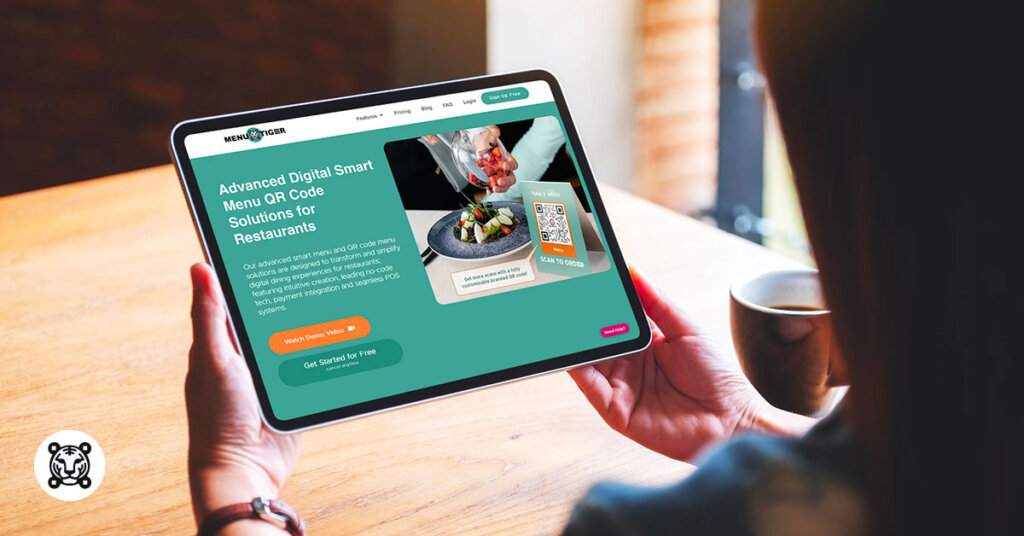
Providing exceptional service and a memorable experience for your patrons is important for the success of your restaurant.
This is where MENU TIGER comes in—a trusted QR code menu software designed to enhance your customers’ dining and streamline your operations.
Easy QR code menu updates
With MENU TIGER, you can say goodbye to the hassle of printing and reprinting menus every time you introduce new dishes or seasonal specials.
The intuitive software provides comprehensive instructions on how to customize a menu QR code to quickly and effortlessly modify your menu, ensuring that your guests are always up-to-date with the latest offerings.
Whether it’s showcasing new food and drink items or highlighting limited-time promotions, this restaurant software makes it easy to keep your menu fresh and engaging.
Extensive customization tools
One size does not fit all when it comes to restaurant menus. A digital menu software for restaurants understands that every establishment has its own unique personality and branding. It allows you to customize your menu layout, colors, and item descriptions to reflect your restaurant’s identity while improving the ordering experience.
That’s why MENU TIGER offers extensive customization options, allowing you to tailor your menu to mirror the ambiance and style of your establishment.
From choosing fonts and colors to adding personalized touches, this software empowers you to create a menu that truly resonates with your customers.
Efficiency in restaurant operations
Simplify the order process and improve the overall efficiency of your restaurant with a digitized menu.
Its user-friendly interface makes it effortless for your customers to explore your menu, browse through offerings, and place their orders—all with just a few taps on their smartphones.
By eliminating the need for physical menus and manual order taking, you can significantly reduce wait times, improve table turnover, and streamline your operations for optimal efficiency.
Optimized for upselling and cross-selling
Increase your revenue and maximize profitability with a QR code menu feature for upselling and cross-selling.
With an active account, you can customize your digital menu and add suggestions of your best food and drink pairings, add-ons, and upgrades based on customers’ menu selections.
This strategic approach will guide your customers through your food and drink menu while enticing them to improve their meals with complementary dishes and beverages.
Tracks customer dietary preferences
Personalization is key to delivering exceptional service in the fine-dining restaurant.
MENU TIGER’s smart menu enables you to cater to the individual dietary preferences and restrictions of your patrons with ease.
The software allows customers to specify their dietary needs—whether they’re vegetarian, gluten-free, or have food allergies—ensuring that they can confidently navigate your menu and find suitable options.
Enhanced analytics and insights
Gain valuable insights into your customers’ preferences, behaviors, and ordering patterns with MENU TIGER’s advanced analytics dashboard.
You can track sales, monitor menu popularity, and identify trends to make strategic decision-making and menu optimization.
By leveraging data-driven insights, you can refine your menu offerings, tailor promotions, and meet the needs and preferences of your customers.

Ready to upgrade your food and beverage pairing? Kickstart with a QR code menu
Generating food and drink pairing ideas from scratch is never easy. You’ll need to schedule a session with connoisseurs or sommeliers or chefs, researching, testing, tasting, and testing again.
It’s a laborious process.
But if you don’t have the extra time to go over these processes, just take note of the suggested pairing ideas mentioned in this article.
Once you’ve curated your ideal menu, go over to a trusted digital menu QR code software to start digitizing your offerings and operation.
All you need is an active email, a paid subscription of your choice, and your fine dining menu.
FAQs
The best food and drink pairings depend on various factors, including flavor profiles, textures, and the occasion.
For example, rich and savory dishes like steak often pair well with full-bodied red wines, while lighter fare such as seafood complements crisp white wines or sparkling varieties.
Additionally, experimenting with contrasting flavors, like pairing spicy foods with slightly sweet beverages, can create exciting and memorable dining experiences.
Standard food and beverage pairings often include classics like steak with red wine, seafood with white wine, and spicy dishes with beer.
Also, cheese pairs well with both wine and beer, while desserts are commonly complemented by sweet wines or coffee-based cocktails. These pairings provide a balanced combination of flavors and enhance the dining experience for patrons.
Food and beverage pairing techniques involve understanding flavor profiles, textures, and intensities to create harmonious combinations. These techniques include matching complementary flavors to enhance each other, contrasting flavors to create balance, and considering the weight of the dish and beverage to ensure a cohesive dining experience.
Experimentation and creativity play key roles in discovering unique and memorable pairings that elevate the overall dining experience.

